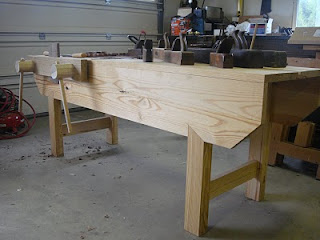

I've been dreaming of a hand tool only woodworking shop for a few years now. For now, I operate out of about a quarter of a 2 car garage. Not terrible; I'm sure some have less of a space than I do, but as I trend more toward working with hand tools, I find myself wanting a detached, dedicated hand tool shop. The good thing about working with hand tools is that you really don't need that big of a space. After all, you don't need to make room for the table saw, power jointer, thickness planer, drill press, band saw, radial arm saw, etc. I've been toying with some different design layouts and different size shops lately. These are the two most promising designs I've come up with so far. I don't have any fancy CAD programs, so these were just done on Exel, hence the crudeness, but you get the idea. The county I'm in doesn't require a building permit for buildings under 300 square feet, so both these come in just under. Any time you can avoid dealing with planning and zoning, I highly recommend you avoid it. I really want this to look more like an 18th century shop than a garage, hence the lack of an overhead garage door. I also want lots of windows to let in lots of natural light. I'm not even sure I'd run electricity to it if it weren't for the hot, humid summers we get here in southern Maryland. I think I'd at least need a fan out there. :) The photos are of the Shoemaker's Shop in Colonial Williamsburg. This is ideally what I'd like my shop to look like on the outside. Or at least somewhat this style. I believe that the area you work in can inspire you to do better work and a shop like this would just make woodworking that much more enjoyable for me.
.gif)



























